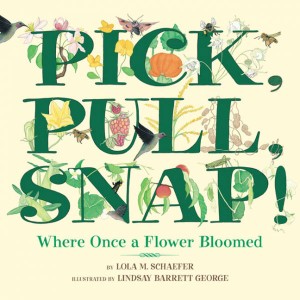Written by Lola M. Schaefer and illustrated by Lindsay Barrett George
Greenwillow Books, 2003
9780688178345
Notable Children’s Books in the Language Arts (NCTE)
Texas Library Association 2X2 Reading List
In the orchard, a honey bee buzzes.
Its legs brush pollen inside a fragrant pink flower.
Peaches and peas and even peanuts – they all begin with a flower.
How?
Open this book and find out!
Reviews
"This lovely picture book describes in simple terms the process by which plants flower, create seeds, and bear fruit, and shows the various stages in stunning, life-sized detail on lush, tri-fold pages. Schaefer takes readers into a garden, orchard, berry patch, and field to explain how peas, raspberries, corn, peaches, peanuts, and pumpkins grow—all beginning with flowers. This creative approach illustrates the plants’ growth, maturation, and various types of pollination. George’s photo-realistic artwork delights the eye and engages the other senses as well…The concepts presented are not easy ones and a bit of abstraction is required, but the explanations are solid. Youngsters will want to rush out, buy some packets of seeds, and get their hands dirty. Growing instructions for the featured plants are appended."—School Library Journal
"…focuses on berry patches, cornfields, an orchard, peanut farm and pumpkin patch. The text details how different produce grow, with gatefold flaps on every spread that open to show the harvest. A glossary and additional information on how and when to plant the foods mentioned wraps up this informative and accessible volume."—Publishers Weekly
"This attractive lift-the-flap title offers a basic introduction to plant growth. On each spread, rhythmic, poetic text describes a plant’s flower or husk and shows a cross section that reveals the seeds inside. A few lines of text explain a plant’s growth, and then the page folds out to reveal the mature plant—peas, raspberries, corn, peanuts, and so on—accompanied by a bouncy refrain, “where once a flower bloomed.” Plenty of facts are left unexplained (for example, What is the relationship between pollen and the developing flowers and seeds?), but the simple, appealing text shows the basic progression of flower to fruit, and George’s inviting, realistic color art brings youngsters up close to plants that produce familiar foods. Back matter gives gardening directions for the featured plants, and a final illustration counts through the months for preschoolers learning the seasons."—Booklist
"Detailed, scientific-quality drawings, simple, accurate explanations, and fold-out pages make this a satisfying treat for gardeners young and old. Featuring six common fruits and vegetables, Schaefer details how each flower is pollinated, forms seeds, and grows into the plant under the flap. The layout is fitting for the naturalistic theme, since it is reminiscent of poetry, down to the repeated line, “…where once a flower bloomed.” She winds down by highlighting the planting cycle’s end in winter, and its beginning again in the spring. The final spread details the pollination and fertilization of a flower, as well as its parts. There are also planting directions for the seeds featured. A glossary allows those without garden experience to better understand the text. George’s illustrations are incredibly detailed, with intricate drawings of parts invisible on any casual visit to the garden. The multiracial children tending the garden are everyday kids with baseball caps and tennis shoes, showing that anyone of any age can harvest the fruits of their labors. Perfect for budding greenthumbs."—Kirkus Reviews
"A breeze blows pollen into a white pea flower. Inside the flower very small seeds begin to grow. The rains help the peas plump up and soon they are ready to eat. A bumblebee buzzes around the raspberry bushes, spreading pollen inside the delicate white flowers. It is the wind that pollinates the silk of the corn flowers. This same scene is played out in the orchard for peaches, and in the garden for peanuts and pumpkins. Beautifully detailed illustrations reveal a cross section of the flower while the fruit is growing. A foldout page pictures a child picking the fruit that came from the flower. With many of us so far from the farmers’ fields and few families planting vegetable gardens, this book offers a great opportunity for children to begin to understand this important part of the life cycle of plants. An addendum informs readers that bees are not the only pollinators. Other animals spread pollen, as well as wind and water. Some plants pollinate themselves. Instructions are provided for planting each of the fruits and vegetables mentioned in the book. The lovely illustrations and die-cut pages make this a unique publication."—Children’s Literature

